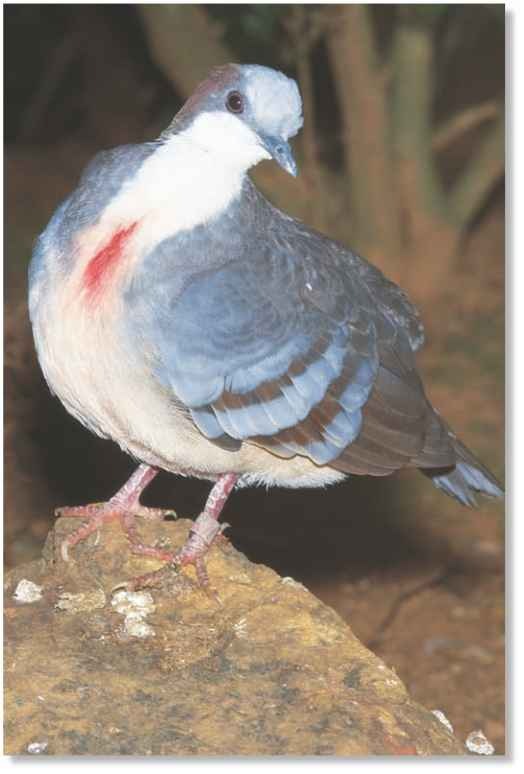ORDER
Columbiform.es
FAMILY
Columbidae
GENUS & SPECIES
key features
• Most striking of all the bleeding-heart pigeons; its breast .markings resemble a deep, bleeding wound
• Only bleeding-heart pigeon to lay two eggs; all others lay just one
• Spends most of its time on the ground, eating whatever edibles it can swallow whole
• Produces crop milk to feed nestlings
where in the world?
Found on only Luzon and Polillo, two islands in the Republic of the Philippines, an archipelago made up of over 7,000 islands; these are part of the Malay archipelago off the southeast coast of Asia
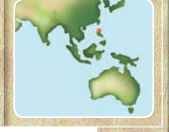
Lifecycle
True to its plumage, the Luzon bleeding-heart fulfills the role of the faithful lover — male and female mate for life. But it also plays the victim, crouching when alarmed.
HABITAT
The Luzon bleeding-heart is named for one of the two islands it inhabits. Luzon is the largest of over 7,000 islands in the Republic of the Philippines. The bird also lives on Polillo, a much smaller island to the east. The Philippine Islands are part of the Malay archipelago, the largest group of islands in the world. About 35% of the islands are woodlands, as are Luzon and Polillo. The mountainous regions and fertile plains on these islands offer an abundance of food for the resident bleeding-heart. The largest freshwater lake in Southeast Asia, Laguna De Bay, is found on Luzon; it is a vital source of freshwater for the Luzon bleeding-heart.
Volcanic Luzon The Luzon bleeding-heart is found on the island of Luzon in the Philippines.

Crop milk contains 65-81% water, so parents must drink more water each day to compensate for the drain on their reserves.
When the Luzon bleeding-heart gets something in its eye, it will rub its eye on its shoulder — this is unusual, since most birds only blink.
BREEDING
The Luzon bleeding-heart mates for life. The male utters a mournful crooo to attract a mate. With a second, similar call, the male declares his loyalty. The two calls are distinct, varying in loudness and intensity, in order to communicate the correct message. After bowing and other courtship displays, the birds use small twigs, roots and grasses to build a nest, low in a bush or tree. The female lays two eggs and incubates for about 17 days. During incubation, both the male’s and female’s crops, an extension of the esophagus, begin to secrete milk, which will be used to feed the down-covered nestlings. After the first few days, the parents add seeds and insects and regurgitate the mixture for the chicks. Luzon bleeding-heart chicks grow quickly with the help of the protein, fat, minerals and vitamins A and B that crop milk supplies. The chicks begin searching for their own seeds and insects by 4 weeks of age.
THE MATING GAME
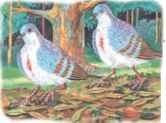
Chasing ’round…
A Luzon bleeding-heart male is strongly attracted to a female and runs after her in an attempt to get her attention.
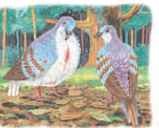
Puffing up…
Interested, the female stops and the courtship show begins. The male inflates his breast enlarging the blood-red patch.
FOOD & FEEDING
The Luzon bleeding-heart is a casual forager — it walks along and turns over soil with flicks of its bill. The bleeding-heart eats fallen seeds, berries, snails, ticks and other insects — almost anything that it can swallow whole, since the bird cannot bite, chew or de-husk its food. If food is not conveniently found on the ground, the bird grabs and tugs to pull suitably sized morsels from plants. The bleeding-heart pigeons all tend to eat more animal food than most other pigeons.
To wash all of the various food items down, the Luzon bleeding-heart drinks at least once a day, usually more. Like all pigeons, the bleeding-heart drinks quickly by sucking in a continuous motion, not lifting the head up to swallow. This ability is unique among birds.
Out to lunch A bleeding-heart searches the ground for food.
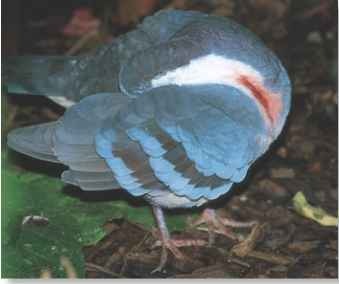
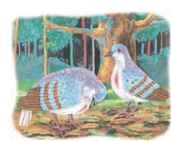
Bowing down…
The male then lowers his head, with his tail pressed firmly to the ground, and emits a rapid “croo-coo”

All grown-up
The female accepts the male’s advances and the pair mates; they will stay together for life.
BEHAVIOR
The Luzon bleeding-heart spends most of its time on the forest floor. It searches for food by turning over leaf litter and dirt; it also stretches quite often, for comfort and possibly to keep its wings loose for a quick getaway if predators approach. To stretch, the bird pulls its folded wings upward while lowering its head and tail, and also stretches one leg backward while extending the wing on the same side. When the bleeding-heart does fly, it is usually with its mate to a nesting site or in small flocks to find water. Highly territorial, the male defends its area, first with warning calls and, if necessary, by fighting to the death. The Luzon bleeding-heart is successfully raised in aviaries around the world, but cannot be mixed with smaller species because of its aggressive nature. When confronted with a larger bird of prey in the wild, the bird emits a grunting, panting or gasping sound.This distress call is often sounded at the sight of other predators, including humans. The bird then flies a short distance, lands and continues its escape by running.
A topnotch watch
A Luzon bleeding-heart perches and scans for unwelcome intruders.
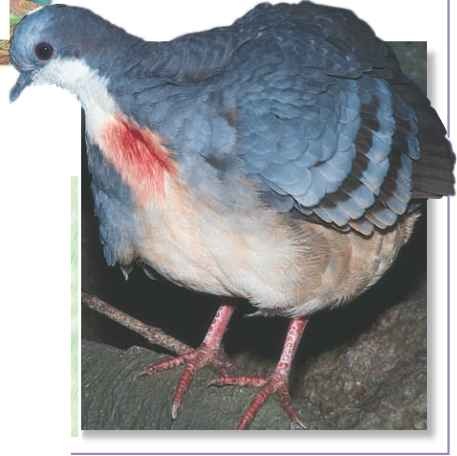
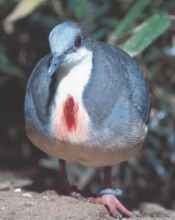
CONSERVATION
In its natural range, the Luzon bleeding-heart is at a low risk of endangerment. The bleeding-heart’s limited range and forest habitat make the bird’s long-term prospects less positive, since the logging industry destroys millions of cubic feet of timber in the Philippines each year.
PROFILE
Luzon Bleeding-heart
The Luzon bleeding-heart appears mortally wounded with its indented breast feathers that are colored blood red.

Luzon bleeding-heart
CREATURE COMPARISONS
Measuring almost 16″ long, the Nicobar pigeon (Caloenas nicobarica) is larger than the Luzon bleeding-heart. Both birds live in the Philippines, where they search for seeds, fruit and insects on the ground. But whereas the Luzon bleeding-heart inhabits the Philippines’ largest island, Luzon, the Nicobar pigeon is found only on small wooded islands and the islets off the larger land masses.The Nicobar pigeon is also found west of the Philippines on the Nicobar Islands, hence its common name.
| vital | |
| statistics | |
| Weight | Unknown |
| Length | 12″ |
| Wingspan | About 14” |
| Sexual Maturity | 18 months |
| Breeding 1 Season | March-June |
| ‘Number Of Eggs | 2 |
| Incubation Period | About . 17 days |
| Fledging Period | About 12 days |
| Breeding Interval | Up to 1 year |
| Typical Diet | Seeds, fruits and invertebrates, including insects |
| Lifespan | Over 20 years |
Related species
• The family Columbidae includes over 300 species of pigeons and doves in 42 genera, found worldwide except Antarctica. The Luzon bleeding-heart is one of 19 species in the genus Gallicolumba. The bleeding-heart pigeons, the less ornamented golden-heart, G. rufigula, and the Celebes quail dove, G. tristigmata, are found in the Malay archipelago. Most islands contain only one species; New Guinea has three.
